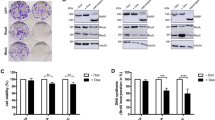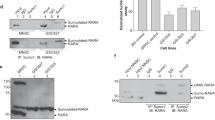Abstract
Although retinoids are known to regulate gene transcription by activating retinoid receptors, the targets of retinoid receptors are largely unknown. This study indicates effective all-trans retinoic acid (RA)-induced differentiation of human embryonal carcinoma cells engages p53. Unexpectedly, RA has been found to activate the transactivation function of p53 in the human embryonal carcinoma cell line, NT2/D1, in a retinoid receptor-dependent manner. A derived RA-resistant line, NT2/D1-R1, is deficient in this activity and is co-resistant to cisplatin. This indicates that RA and cisplatin responses may share a common pathway involving p53 in embryonal carcinomas. RA has no effect on p53 steady-state protein levels in either line. RA enhances endogenous p53 transactivation activity in NT2/D1 but not NT2/D1-R1 cells. In addition, RA induces transactivation activity of a gal4-p53 fusion protein, suggesting that RA activates p53 independent of increasing p53 levels or sequence-specific DNA binding. This activity is absent in retinoic acid receptor γ (RARγ)-deficient NT2/D1-R1 cells but can be restored upon co-transfection with specific RARs. Transient transfection of a dominant-negative p53 construct in NT2/D1 cells blocks the RA-mediated transcriptional decline of a differentiation-sensitive reporter plasmid and enhances survival of NT2/D1 cells following cisplatin treatment. Taken together, these findings indicate that RA activates the intrinsic activation function of p53 by a novel mechanism independent of effects on p53 stability or DNA binding and that this activation may be a general mechanism that contributes to RA-mediated G1 arrest.
This is a preview of subscription content, access via your institution
Access options
Subscribe to this journal
Receive 50 print issues and online access
$259.00 per year
only $5.18 per issue
Buy this article
- Purchase on Springer Link
- Instant access to full article PDF
Prices may be subject to local taxes which are calculated during checkout







Similar content being viewed by others
References
Allemand I, Anglo A, Jeantet AY, Cerutti I, May E . 1999 Oncogene 18: 6521–6530
Andrews PW . 1998 APMIS 106: 158–168
Armstrong RB, Ashenfelter KO, Eckhoff C, Levin AA, Shapiro SS . 1994 The Retinoids, Biology, Chemistry and Medicine. Sporn MB, Roberts AB and Goodman DS. (eds). Raven Press, Ltd: New York pp. 545–572
Arriola EL, Rodriguez-Lopez AM, Hickman JA, Chresta CM . 1999 Oncogene 18: 1457–1464
Boersma AW, Nooter K, Burger H, Kortland CJ, Stoter G . 1997 Cytometry 27: 275–282
Boyle JO, Lonardo F, Chang JH, Klimstra D, Rusch V, Dmitrovsky E . 2001 Clin. Cancer Res. 7: 259–266
Burger H, Nooter K, Boersma AW, Kortland CJ, Stoter G . 1997 Int. J. Cancer 73: 592–599
Burger H, Nooter K, Boersma AW, van Wingerden KE, Looijenga LHJ, Jochemsen AG, Stoter G . 1999 Int. J. Cancer 81: 620–628
Chaganti RS, Houldsworth J . 2000 Cancer Res. 60: 1475–1482
Chambon P . 1996 FASEB J. 10: 940–954
Choi J, Donehower LA . 1999 Cell. Mol. Life Sci. 55: 38–47
Chresta CM, Masters JR, Hickman JA . 1996 Cancer Res. 56: 1834–1841
Collins MD, Mao GE . 1999 Annu. Rev. Pharmacol. Toxicol. 39: 399–430
Dmitrovsky E, Bosl GJ, Chaganti RS . 1990 Cancer Surv. 9: 369–386
El-Deiry WS . 1998 Semin. Cancer Biol. 8: 345–357
Guchelaar HJ, Timmer-Bosscha H, Dam-Meiring A, Uges DR, Oosterhuis JW, de Vries EG, Mulder NH . 1993 Int. J. Cancer 55: 442–447
Hall PA, Lane DP . 1997 Curr. Biol. 7: R144–R147
Hall SR, Campbell LE, Meek DW . 1996 Nucleic Acids Res. 24: 1119–1126
Harvey M, McArthur M, Montgomery C, Bradley A, Donehower LA . 1993 FASEB J. 7: 938–943
Hecker D, Page G, Lohrum M, Weiland S, Scheidtmann KH . 1996 Oncogene 12: 953–961
Heimdal K, Lothe RA, Lystad S, Holm R, Fossa SD, Borresen AL . 1993 Genes Chromosomes Cancer 6: 92–97
Hermeking H, Eick D . 1994 Science 265: 2091–2093
Hirao A, Kong YY, Matsuoka S, Wakeham A, Ruland J, Yoshida H, Liu D, Elledge SJ, Mak TW . 2000 Science 287: 1824–1827
Hong WK, Wittes RE, Hajdu ST, Cvitkovic E, Whitmore WF, Golbey RB . 1977 Cancer 40: 2987–2991
Houldsworth J, Xiao H, Murty VV, Chen WY, Ray B, Reuter VE, Bosl GJ, Chaganti RS . 1998 Oncogene 16: 2345–2349
Hussain SP, Harris CC . 1998 Cancer Res. 58: 4023–4037
International Testicular Cancer Linkage Consortium . 1998 APMIS 106: 64–72
Jetten AM, Jetten ME . 1979 Nature 278: 180–182
Kitareewan S, Spinella MJ, Allopenna J, Reczek PR, Dmitrovsky E . 1999 Oncogene 18: 5747–5755
Levine AJ . 1997 Cell 88: 323–331
Liu M, Iavarone A, Freedman LP . 1996 J. Biol. Chem. 271: 31723–31728
Lutzker SG . 1998 APMIS 106: 85–89
Lutzker SG, Levine AJ . 1996 Nat. Med. 2: 804–810
Maerz WJ, Baselga J, Reuter VE, Mellado B, Myers ML, Bosl GJ, Spinella MJ, Dmitrovsky E . 1998 Oncogene 17: 761–767
Mangelsdorf DJ, Umesono K, Evans RM . 1994 The Retinoids: Biology, Chemistry, and Medicine. Sporn MB, Roberts AB and Goodman DS. (eds). Raven Press, Ltd: New York pp. 319–349
Matin A, Collin GB, Varnum DC, Nadeau JH . 1998 APMIS 106: 174–182
Meek DW . 1999 Oncogene 18: 7666–7675
Miller Jr WH, Moy D, Li A, Grippo JF, Dmitrovsky E . 1990 Oncogene 5: 511–517
Miller Jr WH, Maerz WJ, Kurie J, Moy D, Baselga J, Lucas DA, Grippo JF, Masui H, Dmitrovsky E . 1994 Differentiation 55: 145–152
Moasser MM, DeBlasio A, Dmitrovsky E . 1994 Oncogene 9: 833–840
Moasser MM, Reuter VE, Dmitrovsky E . 1995 Oncogene 10: 1537–1543
Moasser MM, Khoo KS, Maerz WJ, Zelenetz A, Dmitrovsky E . 1996 Differentiation 60: 251–257
Oren M . 1999 J. Biol. Chem. 274: 36031–36034
Ossovskaya VS, Mazo IA, Chernov MV, Chernova OB, Strezoska Z, Kondratov R, Stark GR, Chumakov PM, Gudkov AV . 1996 Proc. Natl. Acad. Sci. USA 93: 10309–10314
Nason-Burchenal K, Dmitrovsky E . 1999 Retinoids: Handbook of Experimental Pharmacology. Nau H and Blaner WS. (eds) Springer-Verlag: Berlin pp. 301–322
Peng HQ, Hogg D, Malkin D, Bailey D, Gallie BL, Bulbul M, Jewett M, Buchanan J, Goss PE . 1993 Cancer Res. 53: 3574–3578
Pera MF, Roach S, Elliss CJ . 1990 Cancer Surv. 9: 243–262
Riou G, Barrois M, Prost S, Terrier MJ, Theodore C, Levine AJ . 1995 Mol. Carcinog. 12: 124–131
Schottenfeld D, Warshauer ME, Sherlock S, Zauber AG, Leder M, Payne R . 1980 Am. J. Epidemiol. 112: 232–246
Schwartz D, Goldfinger N, Kam Z, Rotter V . 1999 Cell Growth Differ. 10: 665–675
Shang Y, Baumrucker CE, Green MH . 1999 J. Biol. Chem. 274: 18005–18010
Sherr CJ, Weber JD . 2000 Curr. Opin. Gent. Dev. 10: 94–99
Shin DM, Xu XC, Lippman SM, Lee JJ, Lee JS, Batsakis JG, Ro JY, Martin JW, Hittelman WN, Lotan R, Hong WK . 1997 Clin. Cancer Res. 3: 875–880
Shin DM, Mao L, Papadimitrakopoulou VM, Clayman G, El-Naggar A, Shin HJ, Lee JJ, Lee JS, Gillenwater A, Myers J, Lippman SM, Hittelman WN, Hong WK . 2000 J. Natl. Cancer Inst. 92: 69–73
Spinella MJ, Kitareewan S, Mellado B, Sekula D, Khoo KS, Dmitrovsky E . 1998 Oncogene 16: 3471–3480
Spinella MJ, Freemantle SJ, Sekula D, Chang JH, Christie AJ, Dmitrovsky E . 1999 J. Biol. Chem. 274: 22013–22018
Wadgaonkar R, Collins T . 1999 J. Biol. Chem. 274: 13760–13767
Yuan H, Corbi N, Basilico C, Dailey L . 1995 Genes Dev. 9: 2635–2645
Zamble DB, Jacks T, Lippard SJ . 1998 Proc. Natl. Acad. Sci. USA 95: 6163–6168
Zauberman A, Flusberg D, Haupt Y, Barak Y, Oren M . 1995 Nucleic Acids Res. 23: 2584–2592
Acknowledgements
We thank Dr Sarah Freemantle and Dr Sutisak Kitareewan for helpful discussion and Mr Jeffrey Chang for technical assistance. We thank Dr Nancy Rosenfield (Memorial Sloan Kettering Cancer Center) for providing DAOY cells. We thank Dr Moshe Oren (Weizmann Institute of Science), Dr Tucker Collins (Harvard Medical School), and Dr Bert Vogelstein (John Hopkins Medical School) for providing plasmid constructs. This work was supported by National Institute of Health R01-CA54494 (E Dmitrovsky) and R01-CA87546 (E Dmitrovsky) from the National Cancer Institute, and by the American Cancer Society grant RPG-90-019-10-DDC (E Dmitrovsky) and the National Cancer Institute Howard Temin Award K01-CA75154 (MJ Spinella) and from a grant from the Lance Armstrong Foundation (MJ Spinella). KH Dragnev was supported in part by the American Society of Clinical Oncology (ASCO) Young Investigator Award.
Author information
Authors and Affiliations
Rights and permissions
About this article
Cite this article
Curtin, J., Dragnev, K., Sekula, D. et al. Retinoic acid activates p53 in human embryonal carcinoma through retinoid receptor-dependent stimulation of p53 transactivation function. Oncogene 20, 2559–2569 (2001). https://doi.org/10.1038/sj.onc.1204370
Received:
Revised:
Accepted:
Issue Date:
DOI: https://doi.org/10.1038/sj.onc.1204370
Keywords
This article is cited by
-
TRAF inhibition drives cancer cell apoptosis and improves retinoic acid sensitivity in multiple cancers models
Discover Oncology (2023)
-
A master of all trades – linking retinoids to different signalling pathways through the multi-purpose receptor STRA6
Cell Death Discovery (2021)
-
Epigenetic drugs and their molecular targets in testicular germ cell tumours
Nature Reviews Urology (2019)
-
Molecular Mechanisms of Cisplatin Chemoresistance and Its Circumventing in Testicular Germ Cell Tumors
Current Oncology Reports (2018)
-
p53: key conductor of all anti-acne therapies
Journal of Translational Medicine (2017)



